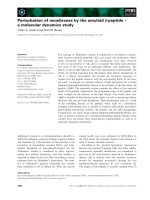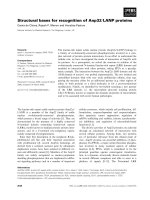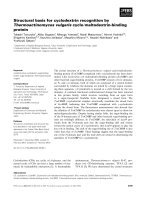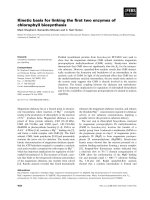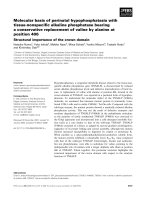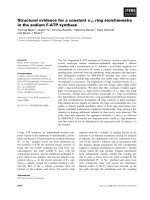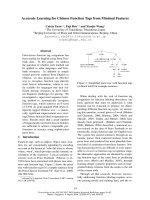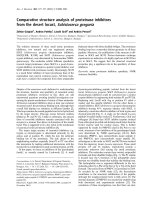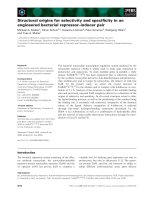Báo cáo khoa học: Structural basis for poor uracil excision from hairpin DNA An NMR study pptx
Bạn đang xem bản rút gọn của tài liệu. Xem và tải ngay bản đầy đủ của tài liệu tại đây (495.58 KB, 9 trang )
Structural basis for poor uracil excision from hairpin DNA
An NMR study
Mahua Ghosh
1
, Nidhi Rumpal
2
, Umesh Varshney
2
and Kandala V. R. Chary
1
1
Department of Chemical Sciences, Tata Institute of Fundamental Research, Colaba, Mumbai, India;
2
Department of Microbiology
and Cell Biology, Indian Institute of Science, Bangalore, India
Two-dimensional N MR and molecular dynamics simula-
tions have been used to determine the three-dimensional
structures of two hairpin DNA structures: d-CTAGAG
GATCCUTTTGGATCCT (abbreviated as U1-hairpin)
and d-CTAGAGGATCCTTUTGGATCCT (abbreviated
as U3-hairpin). The
1
H resonances of both of these hairpin
structures have been assigned almost completely. NMR
restrained molecular dynamics and energy minimization
procedures have been used to describe the three-dimensional
structures of th ese hairpins. This study and concurrent
NMR structural studies on two other d-CTAGAGGA
TCCTUTTGGATCCT (abbreviated as U2-hairpin) and
d-CTAGAGGATCCTTTUGGATCCT (abbreviated as
U4-hairpin) have shed light upon various interactions
reported between Echerichia coli uracil DNA glycosylase
(UDG) and uracil-containing DNA. The backbone torsion
angles, w hich partially influence the local conformation of
U12 and U14 in U1 and U3-h airpins, respectively, a re
probably locked in the trans conformation as in the case of
U
13
in the U2-hairpin. Such a stretched-out backbone con -
formation i n t he vicinity of U
12
and U
14
is thought to be the
reason why the K
m
value is poor for U1- and U3-hairpins as
it is for t he U2-hairpin. Furthermore, the bases U
12
and U
14
in both U 1- and U3-hairpins adopt an anti conformation, in
contrast with the base conformation of U
13
in the U2-hair-
pin, which adopts a syn conformation. The clear discrepancy
observed in t he U-base orientation with respect to the sugar
moieties could explain why the V
max
value is 10- to 20-fold
higher for the U1- and U3-hairpins compared with the
U2-hairpin. Taken together, these observations support our
interpretation that the unfavourable backbone results in a
poor K
m
value, whereas the unfavourable nucleotide con-
formation r esults in a poor V
max
value. These two parame-
ters the refore m ake t he U1 - a nd U3 -hairpins b etter
substrates for UDG compared with the U2-hairpin, as
reported earlier [Kumar, N. V. & Varshney, U. (1997)
Nucleic Acids Res. 25, 2336–2343.].
Keywords: hairpin DNA; molecular dynamics; two-dimen-
sional NMR spectroscopy; uracil DNA glycosylase; uracil
excision.
DNA in cells is unceasingly subjected to damages t hat occur
even under normal physiological conditions. One such
damage is the deamination of cytosine (C) to uracil (U). If
left unrepaired, such damage can cause GC to AT
mutations in the subsequent replication cycle. U may also
be incorporated in place of T by DNA polymerase during
replication. Such misincorporation may impend recognition
of DNA by various regulatory proteins. Therefore, to
maintain genomic integrity, the c ells have uracil DNA
glycosylase (UDG), which excises U from DNA [1].
The single-stranded regions which arise in DNA during
various physiological processes such as replication may
adopt complex secondary and tertiary s tructures. During
the formation of such higher-order stuctures, any unpaired
C is prone to deamination. To understand the complex
mechanism of U excision from such secondary structures,
hairpin DNAs consisting of U in the loop provide useful
model systems. At times, the hairpin loop can o ffer an extra-
helical situation, wherein U is sometimes in a Ôflipped outÕ
form. Thereby, U may be spontaneously recognized by
UDG. Recently, it has been shown that the excision of U
from such hairpin loops by UDG [2,3] is dependent on the
U position in the loop. For a tetra-looped hairpin DNA
(Scheme I), the affinity (K
m
) of UDG towards the
U2-hairpin (see Table 1 [2]) is found to be substantially
lower that that of t he U4-hairpin. This suggests that poor
excision of U from the U2-hairpin could be a consequence
of its lower affinity to for the enzyme. A caveat to this
interpretation, however, is that other substrates (U1 and
U3) also ought to have poorer affinity (high K
m
) towards
the enzyme. Yet, U excision from these s ubstrates is
relatively more efficient (see Table 1 ).
In order to gain an insight into such discrepancies in U
excision we h ave carried o ut structural characterization by
NMR o f the four hairpin DNA structures shown in
Scheme I. As reported earlier, comparison of the three-
dimensional structures of U2- and U4-hairpins revealed that
the stretched-out backbone conformation in the vicinity of
U
13
in the U2-hairpin [4,5] is the reason for the enzyme not
being a ble to make appropriate contacts with the backbone.
Correspondence to K. V. R. Chary, Department of Chemical Sciences,
Tata Institute of F undamental Research, Homi Bhabha Road,
Bombay 400 005, India. Fax: + 91 22 215 2110/2181,
Tel.: + 91 22 215 2971/2979, E-mail:
Abbreviations: UDG, u racil DNA glycosylase; U, uracil.
Dedication: This paper is dedicated to the memory of Prof. M . A.
Viswamitra (1932–2001).
(Received 25 July 2001, revised 16 November 2001, accepted 14
February 2002)
Eur. J. Biochem. 269, 1886–1894 (2002) Ó FEBS 2002 doi:10.1046/j.1432-1033.2002.02837.x
In addition, the protrusion of the U towards the minor
groove side of the hairpin stem may also lead to steric
hindrance in the approach of UDG to DNA. On the other
hand, U
15
in the U4-hairpin, the best substrate of the four, is
located in an environment wherein both the backbone and
the base conformation mimic the B-form of DNA. Thus the
structural features of the U2-hairpin provided an explana-
tion for its poor excision by the enzyme. However, this still
did not explain why the catalytic rate (V
max
) for U excision
in the U 2-hairpin is poor. For productive enzyme–substrate
complex formation, it is essential t hat t he U, which is facing
the minor groove side of the stem, and is in syn configu-
ration with respect to the sugar, be rotated into the major
groove side of the DNA to make a ppropriate contacts in the
active site of the enzyme. Presumably, the potential energy
required for these structural changes to occur before a
productive enzyme substrate complex is formed results in
lower catalytic rates of U release from the U2-hairpin. This
prompted us to suggest that the unfavourable backbone
results in a poor K
m
value, whereas the unfavourable
nucleotide conformation results in a poor V
max
value. This
conclusion, however, raises the question of whether the
conformation of dU in U1- and U3-hairpins is more
favourable in comparison with that in the U 2-hairpin for its
localization into the active site pocket. To address this
question we have carried out the three-dimensional struc-
ture determination of U1- and U3-hairpins by NMR and
restrained molecular dynamics. This paper describes the
intricate details of three-dimensional structures of U1- and
U3-hairpins, as derived from two-dimensional NMR data
and molecular dynamic simulation. This is followed by a
comparison of these structures with that of the previously
reported three-dimensional U2- an d U4-hairpin structures
[4,5]. This study in turn provides an insight into the
interaction of Escherichia coli UDG with U.
MATERIALS AND METHODS
DNA Samples
The U1- and U3-hairpins (Scheme I) were designed such
that a minimum of seven base pairs constitute the stem of
the hairpins with four nucleotides in the loops. The four
nucleotides overhanging at the 5¢ end of the hairpins was
used to facilitate
32
P-labelling by end filling with Klenow
polymerase, when required. The oligonucleotides were
custom made by Ransom Hill Bioscience, Inc. (Ramona,
CA) a nd purified from 18% polyacrylamide/8
M
urea gels
[3], desalted on Sep-pak columns and lyophilized. Purified
hairpins were examined by gel electrophoresis, which
reveals the existence of these oligos as monomers.
Although the overhangs at the 5¢ ends can trigger the
formation of dumb-bells, single hairpins are favoured by
the e fficient end-filling experiments [3]. Cooperative ther-
mal dissociation curves are observed for both of the
hairpins (data not shown) with UV (the melting point,
T
m
45 °C), indicating that the DNA adopts a distinct
and ordered conformation below the T
m
.
NMR
About 8 mg of purified oligomers were dissolved in
0.6 mL of appropriate solvent ( 1.8 m
M
strand concen-
tration or 40 m
M
in nucleoside residues) with no buffer.
5′ CTAGAGGATCC T 5′ CTAGAGGATCC T
3′ TCCTAGG T 3′ TCCTAGG U
U1-hairpin U3-hairpin
5′ CTAGAGGATCC U 5′ CTAGAGGATCC T
3′ TCCTAGG T 3′ TCCTAGG T
U2-hairpin U4-hairpin
U
T
T
T
U
T
T
T
Scheme 1.
Table 1. Kinetic parameters of uracil excision from various DNA substrates and their structural features as derived from NMR data.
Substrate
K
m
a
(· 10
)7
M
)
V
max
b
(· 10
2
)
Relative
V
max
/K
m
c
Phosphate backbone
in the vicinity of U
Uracil glycosidic
torsion angle v
SS-U4
d
6.57 675.7 100 – –
U1-hairpin 39.9 132.0 3.21 Partially stretched Anti
U2-hairpin 40.3 14.5 0.35 Stretched Syn
U3-hairpin 22.7 127.9 5.9 Partially stretched Anti
U4-hairpin 2.5 173.5 66.8 Resembles B-DNA Anti
a
K
m
(dissociation constant) values are for the U residue in the oligonucleotides.
b
V
max
(excision rate) values are in pmol product
formedÆmin
)1
Ælg
)1
protein.
c
Relative V
max
/K
m
are shown as percentage of that for SS-U4.
d
Single-stranded oligonucleotide with uracil at
the fourth position from the 5¢ end.
Ó FEBS 2002 Structural basis for poor uracil excision (Eur. J. Biochem. 269) 1887
For experiments in
2
H
2
O, the oligomers were lyophilized
three times from
2
H
2
O to deprotonate all of the exchange-
able protons, prior to dissolution in 0.6 mL 99.9%
2
H
2
O.
For experiments in H
2
Oamixtureof90%H
2
O and 10%
2
H
2
Owasused.
1
H NMR experiments were carried out on
Varian Unity + 600 and Bruker AMX 500 spectrometers.
The spectra in a mixed solvent of 90% H
2
O/10%
2
H
2
O
include one-dimensional
1
HNMRspectra recordedwith
P1¢1 pulse sequence [6] and t wo-dimensional NOESY [7]
with P1¢1 detection pulse sequence and a mixing t ime of
200 ms. The two-dimen sional experiments in
2
H
2
O include
exclusive (E)-COSY [8], clean TOCSY [ 9] with a mixing
time of 8 0 ms and a set of NOESY spectra with different
mixing times (ranging from 50 to 350 ms). A t emperature
of 32 °C was used in most of the NMR experiments,
although one-dimensional
1
H experiments were c arried ou t
in the range of 15–55 °C. In all the experiments, the
1
H-carrier fr equency was kept at water resonance. In
two-dimensional experiments, time domain data points
were 512 and 4096 along t
1
and t
2
dimensions, respectively.
The data multiplied with sine bell window functions
shifted by p/4 and p/8 along the t
1
and t
2
axes,
respectively, was zero-filled to 1024 data points along the
t
1
dimension prior to two-dimensional Fourier transfor-
mation (FT).
1
H chemical shift calibrations were carried
out with respect to the methyl signal (at 0.0 p.p.m.) of
3-(trimethylsilyl) [3,3,2,2-
2
H] propionate-d
4
,whichhas
been used as an external reference.
Starting structure and structural restraints
The starting structures for both U1- and U3-hairpins were
generated u sing the molecular mod elling p ackage
INSIGHT
-
II
(MSI) on an Iris (Indigo II) workstation as d iscussed earlier
[5]. Distances were estimated from the initial build-up rates
of the build-up curves b y the two spin-approximation as
described earlier [10–12]. Six of the seven base pairs forming
the stems of the hairpins showed evidence of hydrogen
bonding in the
1
H NMR spectrum. Based on such data, the
inter-atomic distances, G(O6)–C(H41), G(H1)–C(N3),
G(H21)–C(O2), A(H61)–T(04) and A(N1)–T(H3) within
each base-pair were restrained in the range 0.17–0.20 nm
with a force constant of 10 kcalÆmol
)1
ÆA
˚
)2
. On the other
hand, the heavy atoms in these base pairs were r estrained
within the range 0.28–0.32 nm with a force constant of
20 kcalÆmol
)1
ÆA
˚
)2
. These constraints were relaxed during
the final stages of the calculations. The strong Nuclear
Overhausser enhancements (nOes) observed between A(H2)
and T(H3) belonging to A : T base pairs, and the analogous
G(H1) and C(H41) belonging to G : C base pairs, were
restrained in the range 0.24–0.33 nm and 0.20–0.30 nm,
respectively. For these constraints a force con stant of
20 kcalÆmol
)1
ÆA
˚
)2
was used. The information about the
range of pseudo-rotational phase angle (P) obtained from
the knowledge of intra-sugar inter-proton vicinal coupling
constants derived from the E-COSY spectrum, was used to
define two of the five sugar ring torsion angles (-C2¢-C3¢-
C4¢-O4¢-and-C1¢-C2¢-C3¢-C4¢-). This information was also
used to define the lower and upper bounds for one of the
backbone torsion angles,
d(-C2¢-C3¢-C4¢-O4¢-). No restraints were used for the rest of
the backbone [a(-O3¢-P-O 5¢-C5¢-), b(-P-O5¢-C5¢-C4¢-),
c(-O5¢-C5¢-C4 ¢-C3¢-), e(-C4¢-C3¢-O3¢-P-) and f(-C3¢-O3¢-P-
O5¢-)] torsion angles. The glycosidic torsion angles (v)were
constrained based on the information derived from the
intra-nucleotide H6/H8-H1¢/H2¢/H2¢ nOe c onnectivities.
For all of these torsion constraints a force constant of
20 kcalÆmol
)1
Ærad
)2
was used.
Molecular dynamics and energy minimization methods
Molecular dynamics simulations were performed with
DISCOVER
software (MSI).
AMBER
force field was used to
calculate the energy of the system. Electrostatic interactions
were calculated using Coulomb’s law with p oint charges
(6–31G* standard ESP charges) [13] and the distance-
dependent dielectric constant. Van der Waals’ contribu-
tions were calculated with a 6–12 Lennard–Jones potential.
A time step of 1 fs was used. To obtain the starting
structure, an initial steepest descent minimization of
100 steps was p erformed on the initial structure followed
by conjugate gradient minimization of 1000 s teps. The
best-fit structure thus obtained was used for restrained
molecular dynamics simulations. Initial random velocities
were assigned with a Maxwell–Boltzmann distribution for
a temperature of 600 K. Two-hund red structures were
collected at 1 ps i ntervals along the restrained molecular
dynamics trajectory. These structures were significantly
different from each other as evident by their pair-wise root
mean square deviations (rmsd). Each of these structures
was cooled to 300 K in steps of 50 K. After each
temperature step, the system was allowed to equilibrate
for 10 ps. This was followed by 500 steps of s teepest
descent minimization and 1000 steps of conjugate gradient
minimization for monitoring the convergence and structure
analysis. In the event of any constraint violation, another
round of dynamics was performed by varying initial
temperature as well as the weight of the restraint. The
molecule was then cooled to 300 K and energy minimized
as mentioned before. This procedure was repeated three
times, until well converged structures were obtained with
zero violations. In these calculations, as discussed earlier
[4], the N MR-derived distance restraints were applied
throughout with the upper and lower bounds of
± 0.05 nm and with force constants of 25 kcalÆmol
)1
ÆA
˚
)2
for all nOes involving nonexchangeable protons,
10 kcalÆmol
)1
ÆA
˚
)2
for all nOes involving exchangeable
protons and the atoms involved in H-bonds. For the
dihedral angle restraints a force constant of 20 kcalÆmol
)1
Æ
rad
)2
was use d.
RESULTS AND DISCUSSION
1
H NMR assignments and secondary structure
of the U1- and U3-hairpins
Sequence-specific
1
H resonance assignments were achieved
by established procedures [14–19]. Fig. 1A and B show
illustrative examples of selected NOESY s pectral regions
of the U1- and U3-hairpins, respectively, with H2¢/H2¢/
CH
3
–H6/H8 nOe connectivities. Except for the serious
overlap seen in the case of H6 resonances belonging to
C
10
,C
11
,C
20
and C
21
,the
1
H r esonance assignments were
straightforward for both of the hairpins. The degeneracy
between these H6 protons could be resolved by the
observation of intra-nucleotide a nd sequential nOes
1888 M. Ghosh et al. (Eur. J. Biochem. 269) Ó FEBS 2002
between their respective CH5 and H2¢/H2 ¢/CH6 protons.
The stereospecific assignment of individual H2¢ and H2¢¢
could be achieved by intensity comparison of the H1¢-H2¢
and H1¢-H2¢¢ cross-peaks [19] in the NOESY spectrum,
wherein the latter was found to be stronger than the
former.
Intra-base pair NOESY cross peaks G
6
(H1)–C
21
(H41/
H42), G
7
(H1)–C
20
(H41/H42), A
8
(H2)–T
19
(H3), T
9
(H3)–
A
18
(H2), C
10
(H41/H42)–G
17
(1NH) and C
11
(H41/H42)–
G
16
(H1) establish a hydrogen bonded base-pairing between
G
6
:C
21
(G
6
and C
21
), G
7
:C
20
,A
8
:T
19
,T
9
:A
18
,
C
10
:G
17
and C
11
:G
16
and hence the conformation of
stems of both of the hairpins. Qualitative analysis of the
relative NOESY cross-peak intensities established t hat the
stems of both the hairpins adopt a right-handed B-DNA
duplex conformation. The nOe data further confirm the
association of A : T and G : C base pairs through Watson
and Crick base-pairing schemes with almost all of the
individual bases in both the stems adopting the anti
conformation with the glycosidic torsion angle, v, ranging
from )80° to )120°. This is based on the observation of
strong intra-nucleotide H2¢-H6/H8 cross-peaks compared
with H2¢-H6/H8 cross-peaks, while H1¢-H6/H8 cross-peaks
are relatively weak or absent. In the case of C
10
,C
11
,C
20
and C
21
we could not establish the respective v-values for
either of the hairpins bec ause of the severe spectral overlap
of H1¢/H2¢/H2¢-H6 cross-peaks. Most of the expected
sequential nOes are seen all along both the nucleotide
stretches. By the end of the assignment procedure, all of the
major cross-peaks in the two-dimensional spectra could be
assigned uniquely. The nOe interactions seen in individual
loop regions essentially govern the folding pattern of
respective loops, which will be discussed later.
Conformation-dependent characteristic multiplet struc-
tures of H2¢-H1¢ and H 2¢¢-H1¢ cross-peaks in the E-COSY
spectra of both the hairpins have been used to estimate
values
3
J(H1¢-H2¢)and
3
J(H1¢-H2¢¢) [19–22]. As discussed
earlier [4], for both of the hairpins, these J-values qualita-
tively indicate that the corresponding sugar rings adopt
conformation in the S domain of the pseudo-rotational m ap
with P ranging from C1 ¢-exo to C3¢-exo (P ¼ 90–198°).
NMR structure determination of U1- and U3-hairpins
Restrained molecular dynamics simulation and energy
minimization calculations were performed o n both
U1- a nd U3-hairpins following the procedure described in
Materials and metho ds.
In th e case of the U1-hairpin, a total of 227 inter-proton
distance constraints ( 10 involving exchangeable protons and
217 involving nonexchangeable protons) and 64 dihedral
angle restraints were used with the force constants described
earlier. All of these constraints have been deposited in the
Protein Data Bank (PDB accession no. 1II1; RCSB ID
Fig. 1. Selected regions of pure-absorption NOESY spectra of (A) the U1-hairpin and (B) the U3-hairpin recorded in 99.9%
2
H
2
O at 305 K and pH 7,
showing intra-strand inter-residue nOe connectivities: CH
3
/H2¢/H2¢¢ protons to H6/H8 protons. Experimental parameters were: s
m
¼ 250 ms,
recycle delay 1 s, 64 scans per t
1
increment, time-domain data points were 800 and 4096 along t
1
and t
2
dimensions, r espectively . The
1
H-carrier
frequency was kept at water resonance. The data were multiplied with sin e-bell window functions sifted by p/4 and p/8 along t
1
and t
2
axes,
respectively, and zero-filled to 1024 data p oints along the t
1
dimension prior to two-dimensional Fourier transmformation. The digital resolution
along x
1
and x
2
axes, corresponds to 5.84 and 1.46 HzÆpt
)1
, respectively.
Ó FEBS 2002 Structural basis for poor uracil excision (Eur. J. Biochem. 269) 1889
RCSB013285; Of the 200 calcu-
lated structures, there are nine structures lying within
2.5 kcalÆmol
)1
of the minimum energy structure. These 10
structures are characterized by low all-atom pair-wise rmsds
in the range 0.25–1.41. Fig. 2 A shows the best-fit super-
imposition o f these 10 structures. The corresponding PDB
files have been deposited in th e Protein Data Bank (PDB ID
1II1; RCSB ID RCSB013285). In the case of the
U3-hairpin, a total of 132 inter-proton distance constraints
(10 involving exchangeable protons and 122 involving
nonexchangeable protons) and 64 dihedral angle restraints
were used with the force constants described earlier. All of
these constraints have been deposited in the Protein Data
Bank (PDB accession no. 1IDX; RCSB ID RCSB013191).
Of the 200 calculated structures, there are five structures
lying within 2.5 kcalÆmol
)1
above the minimum energy
structure. These six structures are characterized by low all-
atom pair-wise rmsds ranging f rom 0.45 to 1.30. Fig. 2B
shows the best-fit superimposition of these six structures.
The corresponding PDB files have been deposited in the
PDB (PDB ID 1IDX; RCSB ID RCSB013191).
Even though only three torsion angles, namely -C2¢-C3¢-
C4¢-O4¢-, -C1¢-C2¢-C3¢-C4¢- and glycosidic torsion angle (v)
were constrained both in the case of U1- and U3-hairpins,
the structures still converged mostly into a narrow range of
torsion angles at the end of molecular dynamics simulation.
The
31
P chemical shifts and
31
P–
1
H vicinal coupling
constants, which would have helped in further restraining
some of the backb one torsion angles (b, c and e), suffer
from extensive s pectral overlaps. The stereo-chemistry of a ll
10 of the U1-hairpin structures and all six U3-hairpin
structures mentioned above, were critically examined for
correct hydrogen-bond lengths and angles in the Watson–
Crick base-pairs, stereochemical feasibility of the various
dihedral angles and any sterically hindered nonbonded
interatomic distances. All of these structures satisfied these
criteria.
Backbone torsion angles in U1- and U3-hairpins
U1-hairpin. The a, b, c,ande for each nucleotide in the
stem of the U1-hairpin DNA in all the 10 structures are
mostly locked into gauche
–
(g
–
), trans (t), gauche
+
(g
+
)and
trans (t) conformations, respectively, similar to those
observed in B-DNA. The only exception is G
16
,whichis
at the 3¢ end of the tetra-loop. For this, a angle ranges from
Fig. 2. Stereoviews showing a best-fit super-
imposition of the final molecular dynamics and
energy minimized simulated structures of (A)
the U1-hair pin and (B) the U3-hairpin.
1890 M. Ghosh et al. (Eur. J. Biochem. 269) Ó FEBS 2002
136 to 153°.Thef-values adopt 104.5° on average and r ange
from 66 to 108° for all of the residues. The d-values adopt
141.5° on an average ranging from 127 to 156°.Inthecase
of the tetra-loop, it is interesting to note that the b, c,ande
of both the T
14
and T
15
nucleotide units get locked into t, g
+
and t conformations, respectively, similar to the stem. On
the other hand, for T
14
and T
15
,thef is locked into g
–
conformation whereas the d adopts 148 and 110 ° on
average, respectively, similar to those observed in B-DNA.
AsfarasT
13
is concerned, the a, b, c,ande are locked into
g
+
, g
–
, t,andt conformations, respectively. The most
striking observation of the loop conformation concerns the
backbone dihedral angles of U
12
For t his, a, b and f adopt
unusual torsional angle values, namely 130, 88.5 and )87°,
respectively, whereas c, d, e adopt those values that are
observed in B-DNA. The dihedral angles that facilitate the
loop formation are a of U12, c of T
13
and a of T
14
,allof
which adopt t conformation and thus stretch the backbone.
U3-hairpin. The a, b, c and e for each nucleotide in the
stem of the U3-hairpin DNA in all six of the structures are
mostly locked in g
–
, t, g
+
and t, conformations, respectively,
similar to those observed in B-DNA. The exceptions are in
the sequence T
19
–C
21
. In this region, the a of T
19
,C
20
and
C
21
adopt values within the range 131–148°,whereasthec
of T
19
and C
20
are unusually in t conformation. The f-values
adopt )96° on average and range from )64 to )12 8° for all
of the r esidues. The d-values adopt 116° on average ranging
from 93 to 139°. In the case of the t etra-loop, the a, b and e
of T
12
,T
13
,U
14
and T
15
nucleotides mostly get locked into
g
–
, t,andt conformations, respectively, similar to the stem.
The dihedral angles that facilitate the loop formation are b
of T
12 and
T
13
, c of T
13
and c, e and f of U14 and perhaps be
to a certain extent c of T
15
, all of which adopt t
conformation and thus stretch the backbone.
Sugar puckers, glycosidic torsion angles
and turning phosphates in U1- and U3-hairpins
U1-hairpin. In all 10 structures, the sugar puckers lie in the
S domain of the pseudo-rotational wheel with the P angle in
the range of 122–152°. The exception is the sugar of T
13
which adopts the O4¢-endo pucker. This is supported by the
observation of strong intra-nucleotide nOes between H1¢
and H4¢ for these nucleotides [21]. A different behaviour for
this nucleotide could be expected , as it is present in the loop
region of the hairpin DNA. As far as the v is concerned,
almost all nucleotide units are in the anti domain, as evident
in the relative intensities of the resolved nOes between the
base and the sugar protons. The v-values range from )100
to )127°. The exception is again in the case of T
13
,which
adopts syn conformation, with an v-value of 38.5° on
Fig. 3. NOESY cross-peaks as seen in the
individual NOESY spectra of U1-, U2- and
U3-hairpins, each recorded with a mixing time
of 100 ms. (A) H2¢/H2¢-UH6 cross peaks
(B) H5/H1¢-UH6 cross peaks.
Ó FEBS 2002 Structural basis for poor uracil excision (Eur. J. Biochem. 269) 1891
average. As mentioned earlier, the c of T
13
and a of T
14
,are
characteristically in ÔtÕ conformation. Because of this, the
backbone takes a sharp bend near the phosphate linking T
13
and T
14
. Similar phosphodiester conformations were found
for the turning phosphates in the case of U2- and
U4-hairpins and CGTTTTCG-type hairpins [23,24]. In
the present study, t he simulated model reveals that the
turning phosphate is indeed in between T
13
and T
14
.
U3-hairpin. In all the six structures, the sugar puckers lie in
the S domain of the pseudo-rotational wheel and most of
the nucleotides assume a sugar pucker in the range of
93°)155°. All those nucleotides which adopt O4¢-endo
puckers show a strong intra-nucleotide nOe which is
expected between the H1¢ and H4¢ [21]. As far as the
v-value is concerned, almost all the nucleotide units are in
the ÔantiÕ domain, as are evident in the relative intensities of
the resolved nOes between the base and the sugar protons.
The v-values range from )116 to )160°. The exceptions are
in the case of C
11
and T
13
which adopt )58 .5 and )14.5°,
respectively, on an average. As mentioned earlier, the c of
T
13
, c, e and f for U
14
and c of T
15
are characteristically in ÔtÕ
conformation. Because of this, the backbone takes a sharp
swerve near the phosphate linking T
13
and U
14
. Similar
phosphodiester conformations were found for the turning
phosphates in the case of U1, U2- and U 4-hairpins [4,9] and
CGTTTTCG-type hairpins [23,24]. In the present study,
the simulated model reveals that the turning phosphate is
indeed between T
13
and U
14
.
Comparison of U1 and U3-hairpin structure
with U2-hairpin DNA
It is interesting to compare the three-dimensional structure
of U1- and U3-hairpins with that of U2-hairpin [4]. All the
stems of U1, U2 and U3 are found to contain Watson–
Crick base pairs adopting a right-handed B-DNA confor-
mation. Besides, interesting common features are noted
regarding the conformation of the loop of these hairpins.
In all the hairpins, the right-handed backbone continued
through the 3¢ top of the stem to the 5¢ top of the stem, by
taking one sharp turn. The loops are characterized by the
stacking of individual bases (T)
d
(T/U)
c
(The nucleotide T
or U at the position ÔcÕ of the tetra-loop from the 3¢ to p of
the stem), and (U/T)
b
over the 5¢ top of the stem as seen
earlier in the case of CGTTTTCG-type hairpins [23,24].
These fi ndings are c onsistent with the observed inter-
nucleotide n Oes in each case. The most striking feature of
U1- and U3-hairpin loops, however, is the base conforma-
tion of U nucleotides (U
12
and U
14
, respectively), which
adopt an anti conformation with respect to their sugar
moiety. As for U2-hairpin the U
13
base adopts a syn
conformation. These observations are supported by the
volumes of intra-nucleotide base-sugar (H6–H1¢/H2¢/H2¢)
nOes seen in respective NOESY spectra (Fig. 3A,B).
Unfavourable nucleotide conformation results
in poor uracil excision rate
As mentioned earlier, while comparing the three-dimen-
sional structures of U2- and U4-hairpins [4], it was
suggested that the stretched-out backbone conformation
in the vicinity of U
13
in the U2-hairpin could be as the
reason for the enzyme not being able to make proper
contacts with the backbone. Recent three-dimensional
structural analysis of the UDGs from human and E. coli
[25,26] have demonstrated that the UDG establishes
contacts with the DNA backbone through several hydro-
gen bonds to the highly conserved serine residues, which
are present in the active site s of the enzymes. It is also of
interest that in the conformation of DNA in the UDG–
DNA cocrystal structure [27], the position where the U is
located gets kinked. During this kinking the interphosphate
(flanking the U residue) distance is compressed by 4 A
˚
[27].
This implies that the phosphates present on the either end
(5¢ and 3¢) of U are important in substrate recognition by
UDG.
The m ost striking feature of U1- and U3-hairpin
structures, in the vicinity of respective U, i s in their
backbone conformations that are partially in stretched out
form (Fig. 4) as was seen in the case of U2-hairpin [ 4]. Such
stretched-out conformation could be the reason why
Fig. 4. Expanded loop regions of (A) the U1-hairpin and (B) the
U3-hairpin.
1892 M. Ghosh et al. (Eur. J. Biochem. 269) Ó FEBS 2002
the observed values of K
m
are poor for both U1 and
U3-hairpins as in the case of U2-hairpin.
On the other hand, as described earlier both the U
12
and
U
14
bases in both U1- and U3-hairpins adopt an anti
conformation (Fig. 4) in contrast with the base conforma-
tion of U
13
in the U2-hairpin, which adopts syn conforma-
tion [4]. Thus, such marked discrepancy observed in the
U-base orientation with respect to the sugar moieties could
be the reason why the V
max
is almost 10- to 20-fold lower f or
the U2-hairpin compared with the U1-, and U3-hairpins.
Further, it is worth m entioning here that U
15
of the
U4-hairpin, which is the best substrate of all of the four
hairpin DNA structures, is located in an environment
wherein the backbone as well as the base conformation
mimic the B-form of DNA [5]. Thus, taken together, these
observations support our interpretation that the unfavour-
able backbone results in poor K
m
, whereas the unfavourable
nucleotide conformation results in poor V
max
and jointly
these parameters make U1- and U3-hairpins better
substrates for UDG than U2-hairpins.
ACKNOWLEDGEMENTS
The f acilities provided by the National Facility for High Field NMR
supported by the Department of Science and Technology (DST),
Department of Biotechnology (DBT), Council of Scientific and
Industrial Research (CSIR), and Tata Institute of Fundamental
Research, are gratefully acknowledged. Part of the work was supported
by the DBT.
REFERENCES
1. Krokan, H.E., Standal, R. & Slupphaug, G. (1997) DNA
glycosylases in the b ase excision r epair of DNA. Biochem. J. 325,
1–16.
2. Kumar, N.V. & Varshney, U. (1997) Contrasting effects of single
stranded DNA binding protein on the activity of uracil DNA
glycosylase from Escherichia coli towards different DNA sub-
strates. Nucl. Acids Res. 25, 2336–2343.
3. Kumar, N.V. (1999) PhD Thesis. M echanism of uracil excision
from different structural contexts of DNA oligomers b y E. coli
uracil DNA glycosylase and its applicatio ns’ submitted, Septem-
ber 1997. Indian Institute of Science, Bangalore.
4. Ghosh, M., Kumar, N.V., Varshney, U . & Chary, K.V.R. (2000)
Structural basis for uracil DNA glycosylase interaction with
uracil: NMR study. Nucleic Acids Res. 28, 1906–1912.
5. Ghosh, M., Kumar, N.V., Varshney, U. & Chary, K.V.R.
(1999) Structural characterization of a uracil containing hairpin
DNA by NMR and molecular dynamics. N ucleic Acids Res. 27,
3938–3944.
6. Hore, P.J. (1983) S olvent supp ression in Fourier transform NMR.
J. Magn. Res. 55, 283–300.
7. Kumar, A., Wagner, G., Ernst, R.R. & Wuthrich, K . ( 1980) Studies
of J-connectives and sele ctive
1
H-
1
HOverhausereffectsinH
2
O
solutions of biological ma cromolecules by two-dimensional NMR
experiments. Biochem. Biophys. Res. Commun. 96, 1156–1163.
8. Griesinger, C., Sorensen, O.W. & Ernst, R.R. (1986) Correlation
of co nnec ted transitions by two-dimensional NMR-spectro scopy.
J. Chem. Phys. 85, 6837.
9. Grieseinger, C., Otting, G., Wuthrich, K. & Ernst, R.R. (1988)
Clean-TOCSY for
1
H spin system identification in macro-
molecules. J. Am. Chem. Soc. 110, 7870–7872.
10. Kumar, A., Wagner, G., Ernst, R.R. & Wuthrich, K. (1981)
Build-up rates o f the nuclear Ove rhauser effects measured b y
two-dimensional proton magnetic resonance spectroscopy:
Implications for studies of protein conformation. J. Am. C hem .
Soc. 103, 3654–3658.
11. Wagner, G. & Wuthrich, K. (1979) Truncated driven nuclear
Overhauser effect (TOE). A new technique for studies of selective
1
H-
1
H Overhausser effects in the presence of spin diffusion.
J. Magn. Reson. 33, 675–680.
12. Chary, K.V.R., Hosur, R.V., Govil, G., Chen, C. & Miles, H.T.
(1988) Sequence-specific solution structure of d -GGTACGC
TACC. Biochemistry 27, 3858–3867.
13. Cornell, W.D., Cieplak, P., Bayly, C.I., G ould, I.R., M erz, K.M.,
Ferguson, D.M., Spellmeyer, D.C., Fox, T., Caldwell, J.W. &
Kollman, P.A. (1995) A second generation force field for the
simulation of proteins and nucleic acids. J. Am. Chem. Soc. 117,
5179–5197.
14. Feigon, J., Leupin, W., Denny, W.A. & Kearns, D.R. (1983) Two-
dimensional proton nuclear magnetic resonance investigation of
the s ynthetic deoxyribonucleic acid decamer d-(ATATCGATAT)
2. Biochemistry 22, 5943–5951.
15. Scheek, R.M., Boelens, R., Russo, N., van Boom, J.H. & Kaptein,
R. (1984) Sequential resonance assignments in
1
HNMRspectraof
oligonucleotides by two-dimensional NMR spectroscopy. Bio-
chemistry 23, 1371–1376.
16. Wuthrich, K. (1986) NMR of Proteins and Nucleic Acids.John
Wiley and Sons, New York.
17. Reid, B.R. (1987) Sequence-specific assignments and their use in
NMR studies of D NA stru cture. Quart. Rev. Biophys. 20, 1–34.
18. Chary, K .V.R., Hosur, R.V., Govil, G., Tan, Z K. & Miles, H.T.
(1987) Novel solution conformation DNA observed in
d (GAATTCGAATTC) by two-dimensional NMR spectroscop y.
Biochemistry 26, 1315–1322.
19. Chary, K.V.R., Hosur, R.V., Govil, G., Chen, C. & Miles, H.T.
(1989) Quantification of D NA structure from NMR data: con-
formation of d-ACATCGATGT. Biochemistry 28, 5240.
20. Chary, K.V.R. (1991) Magnetic Resonance–Current Trends.
Narosa Publishing House, New Dehli, 71–104.
21. Chary, K.V.R. & Modi, S. (1988) Analysis of intrasugar inter-
proton NOESY c ross-peaks a s an aid to determine sugar geo-
metries in DNA fragments. FEB S Lett . 233, 319–325.
22. Rinkel, L.J. & A ltona, C. (1987) Conformational analysis of the
deoxyribofuranose ring in DNA by means o f sums of proton–
proton coupling constants: a graphical method. J. Biomol. Struct.
Dyn. 4, 621–649.
23. Hare, D.R. & Reid, B.R. (1986) Three-dimensional structure of a
DNA hairpin in solution: two-dimensional NM R studies and
distance calculations on d (CGCGTTTTCGCG). Biochemistry
25, 5341–5350.
24. Baxter,S.M.,Greizerstein,M.B.,Kushlan,D.M.&Ashley,G.W.
(1993) Conformational properties of DNA hairpins with TTT and
TTTT loops. Biochemistry 32, 8702–8711.
25. Parikh, S.S., Putnam, C.D. & Tainer, J.A. (2000) Lessons learned
from structural results on uracil-DNA glycosylase. Mutation Res.
460, 183–199.
26. Pearl, L.H. (2000) Structure and function in the uracil-DNA
glycosylase superfamily. Mutation Res. 460, 165–181.
27. Parikh, S.S., Mol, C.D., Slupphaug, G., Bharati, S., Krokan, H.E.
& Tainer, J.A. (1998) Base excision repair initiation revealed by
crystal structures and binding kinetics of human uracil-DNA
glycosylase with DNA. EMBO J. 17, 5214–5226.
SUPPLEMENTARY MATERIAL
The following material is available from ck
well-science.com/products/journals/suppmat/EJB/
EJB2837/EJB2837sm.htm
Table S1.
1
H NMR chemical shifts of exchangable and
nonexchangable protons in the U1-hairpin.
Ó FEBS 2002 Structural basis for poor uracil excision (Eur. J. Biochem. 269) 1893
Table S2.
1
H NMR chemical shifts of exchangeable a nd
nonexchangable protons in U3-hairpin.
Table S3. All atom pair-wise rmsds among the 10 lowest
energy structures of the U1-hairpin.
Table S4. Mean values with SD of all the backbone torsion
angles and glycosidic torsion angles for all the 10 structures of
U1-hairpin.
Table S5. All atom pair-wise rmsds among the six lowest
energy structures of U3-hairpin.
Table S6. Mean values with SD of all the backbone torsion
angles and glycosidic torsion angles for all the six structures of
U3-hairpin.
Table S7. Integral volumes o f intranucleotide base-sugar
(H6–H1¢/H2¢/H2¢) nOes seen in the respective NOESY
spectra of U1 and U2 and U3-haiprins.
1894 M. Ghosh et al. (Eur. J. Biochem. 269) Ó FEBS 2002

